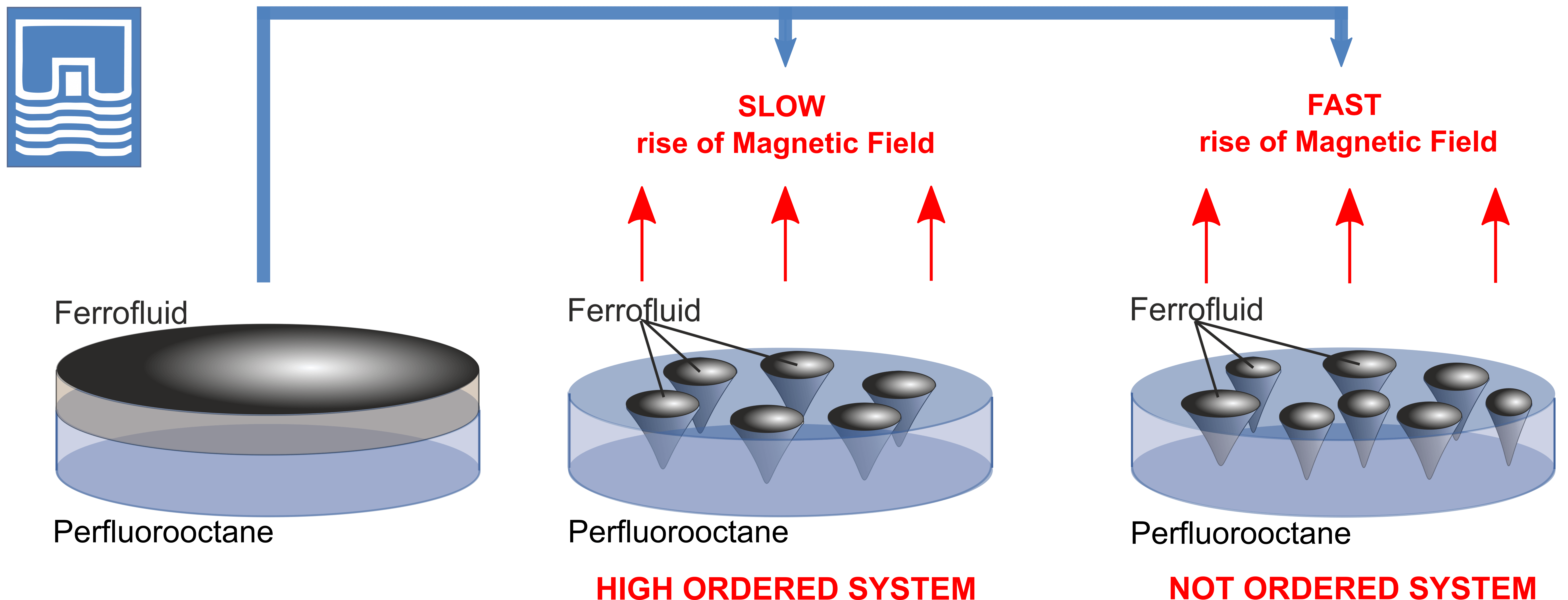 Open Access
Open Access
ARTICLE
The Disintegration of a Floating Ferrofluid Layer into an Ordered Drop System in a Vertical Magnetic Field
1 Laboratory of Dispersed System Dynamics, Institute of Continuous Media Mechanics UrB RAS, Perm, 614018, Russia
2 Laboratory of Hydrodynamical Stability, Institute of Continuous Media Mechanics UrB RAS, Perm, 614018, Russia
3 Laboratory of Turbulence, Institute of Continuous Media Mechanics UrB RAS, Perm, 614018, Russia
* Corresponding Author: Christina Khokhryakova. Email:
(This article belongs to the Special Issue: Advanced Problems in Fluid Mechanics)
Fluid Dynamics & Materials Processing 2024, 20(10), 2205-2218. https://doi.org/10.32604/fdmp.2024.051053
Received 26 February 2024; Accepted 13 June 2024; Issue published 23 September 2024
Abstract
Magnetic fluids, also known as ferrofluids, are versatile functional materials with a wide range of applications. These applications span from industrial uses such as vacuum seals, actuators, and acoustic devices to medical uses, including serving as contrast agents for magnetic resonance imaging (MRI), delivering medications to specific locations within the body, and magnetic hyperthermia for cancer treatment. The use of a non-wettable immiscible liquid substrate to support a layer of magnetic fluid opens up new possibilities for studying various fluid flows and related instabilities in multi-phase systems with both a free surface and an interface. The presence of two deformable boundaries within a ferrofluid layer significantly reduces the critical magnetic field strength required to transform the layer into an organized system of drops or polygonal figures evolving according to the intensity, frequency and direction of the considered magnetic field. This paper experimentally investigates this problem by assuming a uniform magnetic field perpendicular to the surface. This specific subject has not been previously explored experimentally. The critical magnetic field intensity required to destabilize the ferrofluid layer is determined based on the layer’s thickness and the fluid’s initial magnetic susceptibility. It is demonstrated that the critical magnetic field strength needed to disrupt the initially continuous ferrofluid layer increases with the layer’s thickness. Conversely, an increase in the ferrofluid’s magnetic susceptibility results in a decrease in the critical magnetic field strength. The emerging droplet structures are analyzed in terms of the number of drops, their size, and the periodicity of their arrangement. The number of droplets formed depends on the initial thickness of the layer, the presence or absence of a stable rupture in the upper layer, and the rate at which the magnetic field strength is increased to the critical value. A characteristic viscous time is proposed to evaluate the decomposition of the ferrofluid layer, which depends on the duration of the magnetic field’s application. The experimental data on the instability of a ferrofluid layer on a liquid substrate are compared with the theoretical results from the study of “magnetic fluid sandwich structures” conducted by Rannacher and Engel. This comparison highlights the similarities and differences between experimental observations and theoretical predictions, providing a deeper understanding of the behavior of ferrofluid layers under the influence of magnetic fields.Graphic Abstract

Keywords
Cite This Article
 Copyright © 2024 The Author(s). Published by Tech Science Press.
Copyright © 2024 The Author(s). Published by Tech Science Press.This work is licensed under a Creative Commons Attribution 4.0 International License , which permits unrestricted use, distribution, and reproduction in any medium, provided the original work is properly cited.


 Submit a Paper
Submit a Paper Propose a Special lssue
Propose a Special lssue View Full Text
View Full Text Download PDF
Download PDF Downloads
Downloads
 Citation Tools
Citation Tools